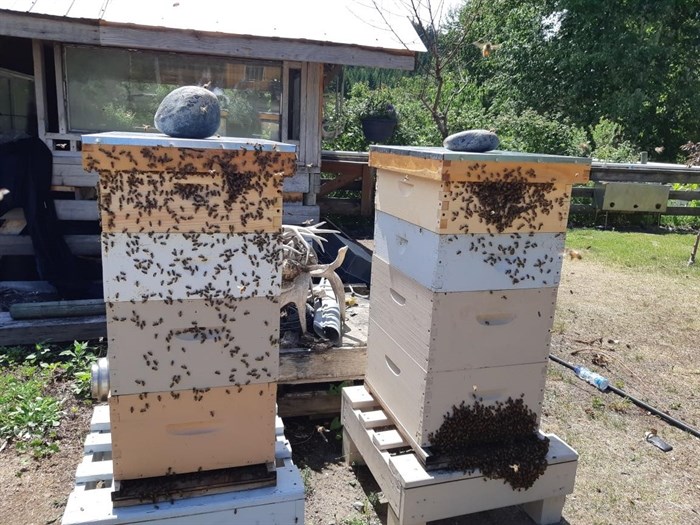
Bee hives on a farm in the Kamloops area in 2021.
Image Credit: SUBMITTED/ Kenton Moore
May 11, 2022 - 6:30 AM
Some beekeepers are seeing scary declines in bee populations this spring in Kamloops and Okanagan regions, but it appears the Kamloops area may have been hit the hardest.
Bee populations are negatively impacted by Varroa mites and flooding along with temperature extremes and windchill, all factors that threatened bees in various regions of the province in 2021.
The bee population continues to decline and is a serious concern for local beekeepers.
“I lost 70 per cent of my hives over the winter,” said long-time Kamloops beekeeper Murray Willis.
Willis recently attended a meeting with the Kamloops Beekeepers Association.
“Most beekeepers in this area suffered major losses,” he said. “An average loss is 30 per cent and this year it is 30 to 100 per cent. This is one of the worst years we’ve ever seen, and similar losses can be seen in regions across the country.”
Willis said the summer heat dome in 2021 was a big factor. Last summer, temperature records were broken across the province.
READ MORE: Similkameen beekeeper concerned about heat this summer
Extreme heat alters the queen bee's system.
“The queens overheat and their reproductive organs don’t work properly,” he said. “The bees used up valuable resources trying to keep cool. They went into winter and then there was a warm spell at the end of December. January was really cold and they couldn’t heat up fast enough.”
The province surveys beekeepers every year and the results of this year's will be released in June.
Provincial apiculturist Paul van Westendorp said preliminary losses of B.C. hives have been a “smorgasbord” of results with some reporting significant losses while others report the best year they’ve had.
van Westendorp attended a recent meeting with the beekeepers in Kamloops and told them it is impossible to nail down exactly why the populations here are so low, Willis said, adding they can't give up trying to increase bee numbers.
Contrary to the losses being reported in Kamloops, Kayes Bees Apiary in Kelowna is doing well.
“We are doing OK as far as numbers but not grand,” said owner Bob Chism. “We have had some losses, but that is normal and this year is nothing out of the normal range. Our bees seemed to fare well enough during the heat dome last summer and wintered well.”
Likewise, Kevin Dunn of Okanagan Wildbrush Honey in Penticton said the survival rate was not great, but the losses were not overwhelming.
He said around 70% of their bees survived the winter, while typically they’ll see about 85% survival rates.
“We keep notes on our queens and one thing we did discover is the late season queens were the ones who had difficulty because they were mated during the heat dome,” he said. “The bees handled the winter fairly well.”
READ MORE: iN VIDEO: The challenges faced by these Kamloops beekeepers
Dunn credits his steadier populations to minor details he is able to incorporate and the fact he is a smaller operation as opposed to a large, commercial one.
“We winter our colonies in two story colonies with honey in the top box for them to feed on for energy,” he said. “This is opposed to feeding sugar or syrup in spring to get them up and going again, and I think it is a much better energy source.”
Dunn integrates an organic based program for mite control, using screens on the bottom boards of the hives that act as mite traps.
“The program is not perfect but it has worked well for us over the years,” he said. “We also don’t have big holding yard, maybe up to 30 hives are kept in one yard so the bees don’t have to compete as much for spring forage.”
Dunn relies on leased bees from commercial apiaries during pollination time.
When asked why he thinks bees in one area can be hit so much harder than another, he said different regions have different challenges and weather patterns that can make significant impacts at certain times in the season.
“On a positive note to beekeepers suffering losses, they still have time to build back up,” he said. “And beekeepers have strategies to recover, they know their stuff. It is just a lot on their plates right now.”
You can support bees in your area by planting bee friendly plants, providing bees with a fresh water source and being careful with insecticide applications. You can also support your local beekeeper by buying local honey.
To contact a reporter for this story, email Shannon Ainslie or call 250-819-6089 or email the editor. You can also submit photos, videos or news tips to the newsroom and be entered to win a monthly prize draw.
We welcome your comments and opinions on our stories but play nice. We won't censor or delete comments unless they contain off-topic statements or links, unnecessary vulgarity, false facts, spam or obviously fake profiles. If you have any concerns about what you see in comments, email the editor in the link above.
News from © iNFOnews, 2022